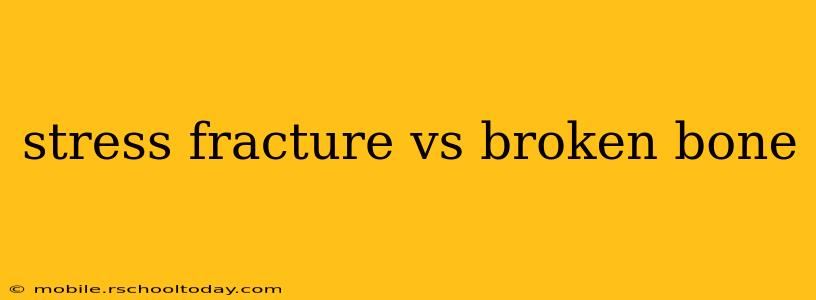Stress fractures and broken bones (fractures) both involve damage to a bone, but they differ significantly in their cause, symptoms, and healing process. Understanding these differences is crucial for proper diagnosis and treatment. This comprehensive guide will explore the key distinctions between stress fractures and broken bones, answering common questions along the way.
What is a Stress Fracture?
A stress fracture is a tiny crack in a bone, typically caused by repetitive, low-impact stress over time. Unlike a sudden, high-impact fracture, stress fractures develop gradually. Think of it like repeatedly bending a paperclip until it finally snaps. These fractures are most common in weight-bearing bones like the feet, legs, and spine, particularly among athletes and individuals engaging in high-impact activities. The bone doesn't break completely; instead, it develops microscopic cracks that weaken the bone's structure.
What is a Broken Bone (Fracture)?
A broken bone, or fracture, is a complete break or crack in a bone. This type of injury usually results from a single, high-impact event like a fall, car accident, or direct blow. Fractures can range in severity from a hairline crack to a complete shattering of the bone, often requiring significant medical intervention. The symptoms are generally more pronounced than those of a stress fracture.
What are the Symptoms of a Stress Fracture?
Symptoms of a stress fracture are often subtle and can be easily overlooked, especially in the early stages. They may include:
- Localized pain: Pain is usually felt at the fracture site and worsens with activity.
- Swelling: Minimal swelling may be present.
- Tenderness to the touch: The area may be painful to the touch.
- Limited range of motion: Movement of the affected area may be restricted.
The pain associated with a stress fracture typically increases gradually and may subside with rest, only to return with renewed activity.
What are the Symptoms of a Broken Bone?
Symptoms of a broken bone are generally more severe and obvious than those of a stress fracture:
- Severe pain: Immediate, intense pain is a hallmark of a broken bone.
- Swelling and bruising: Significant swelling and bruising are common.
- Deformity: The bone may appear visibly out of place or deformed.
- Loss of function: The affected limb may be unable to bear weight or perform its normal functions.
- Inability to move the limb: Pain may make moving the limb impossible.
How are Stress Fractures and Broken Bones Diagnosed?
Diagnosing stress fractures can be challenging, as the subtle symptoms might be initially mistaken for other conditions. Doctors often use the following methods:
- Physical examination: A thorough physical exam to assess the pain, swelling, and tenderness.
- X-rays: While initial x-rays might not always reveal stress fractures, they're essential to rule out other injuries. A stress fracture might only be visible on x-rays several weeks after the onset of symptoms.
- Bone scans: Bone scans (scintigraphy) are more sensitive in detecting stress fractures than x-rays.
- MRI scans: MRI provides detailed images of the bone and surrounding soft tissues, offering a definitive diagnosis.
Diagnosing a broken bone, on the other hand, usually involves:
- Physical examination: The visible deformity, pain, and inability to move the limb often provide a clear indication of a fracture.
- X-rays: X-rays are the primary diagnostic tool for broken bones, providing clear images of the bone and the extent of the fracture.
How are Stress Fractures and Broken Bones Treated?
Treatment for stress fractures focuses on rest, immobilization, and pain management. This often involves:
- Rest: Avoiding activities that cause pain is crucial.
- Immobilization: Using crutches or a cast to prevent further stress on the bone.
- Pain medication: Over-the-counter pain relievers or prescription medications may be necessary.
- Physical therapy: Physical therapy can help restore strength and range of motion after the bone has healed.
Treatment for broken bones depends on the severity of the fracture:
- Immobilization: A cast, splint, or external fixator may be needed to immobilize the bone and allow it to heal.
- Surgery: In some cases, surgery is required to realign the bone fragments or stabilize the fracture.
- Pain medication: Pain medication is frequently prescribed to manage pain.
- Physical therapy: Physical therapy plays a key role in regaining strength and function after the bone has healed.
What is the Healing Time for a Stress Fracture vs. a Broken Bone?
Healing time varies depending on the severity of the injury, the individual's overall health, and adherence to the treatment plan. Generally, stress fractures heal within 6 to 8 weeks with proper rest and treatment, while broken bones can take anywhere from several weeks to several months to heal completely.
Can a Stress Fracture Become a Broken Bone?
While not always the case, a stress fracture can progress to a complete fracture if not properly treated and rested. Continued stress on the weakened bone can lead to a complete break.
This detailed comparison of stress fractures and broken bones should provide a clearer understanding of their differences. Remember, seeking professional medical advice is crucial for proper diagnosis and treatment. Self-treating can lead to complications and delay healing.
